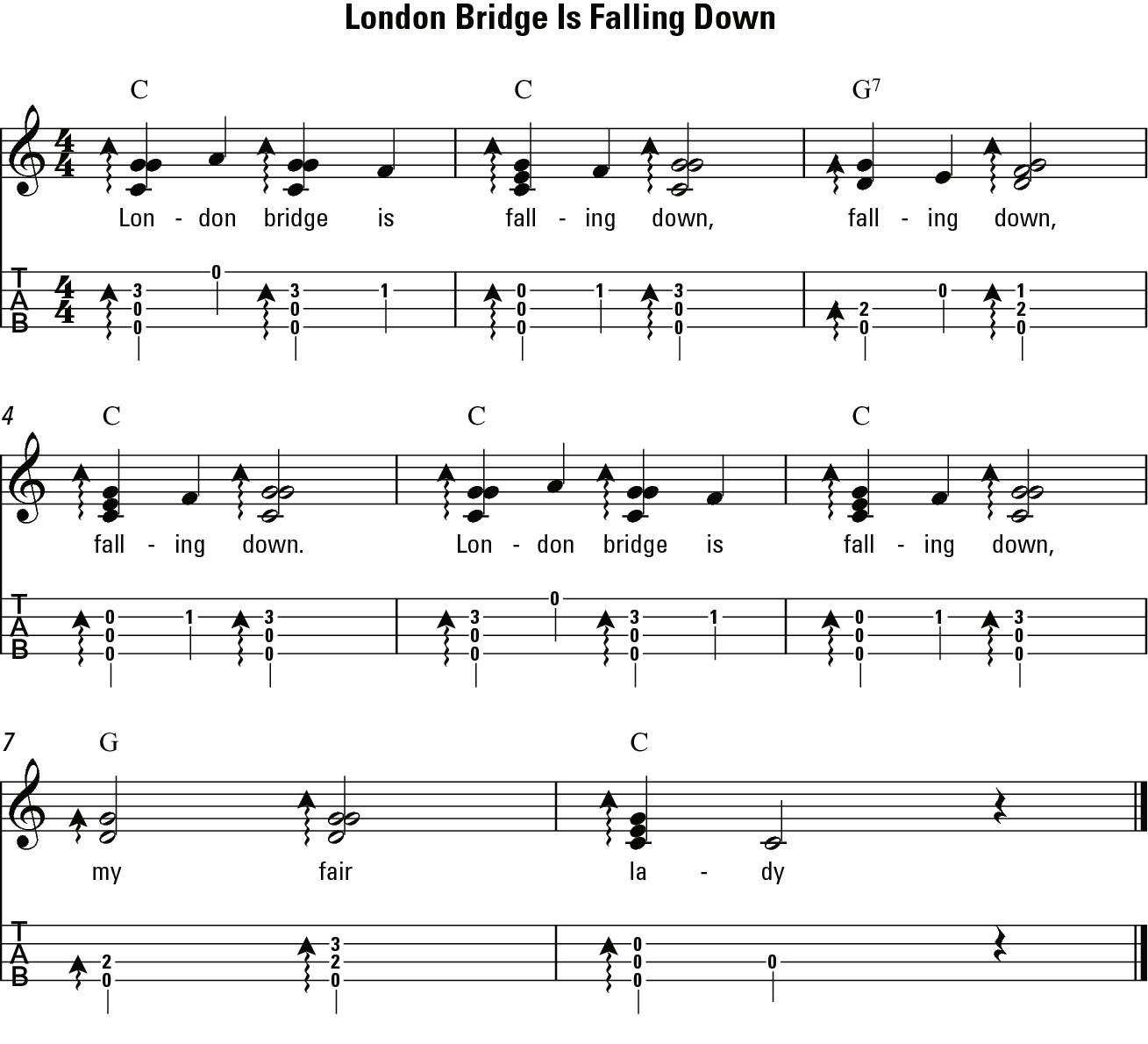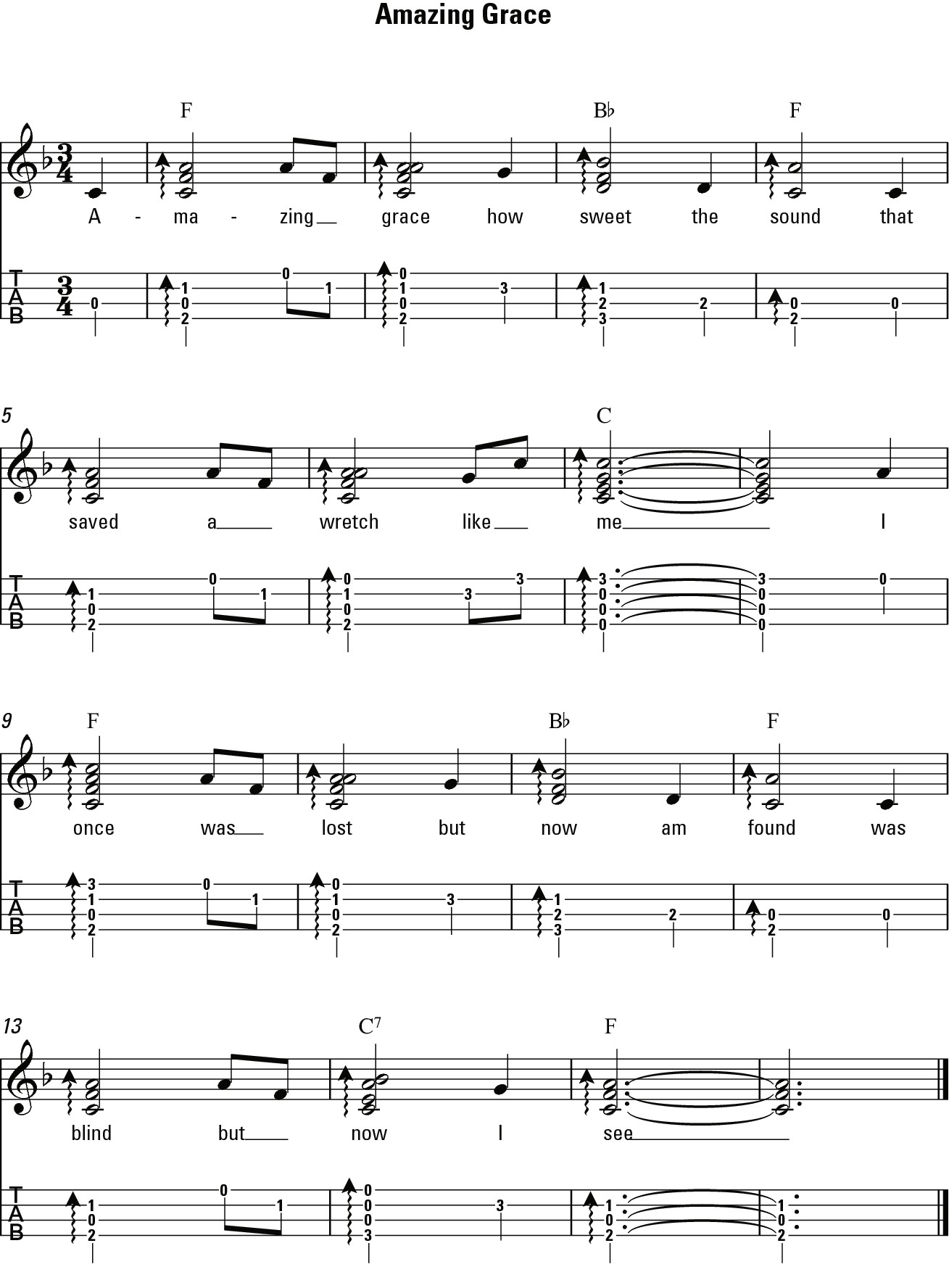Ukulele For Dummies (39 page)
Read Ukulele For Dummies Online
Authors: Alistair Wood

You can produce a number of variations using this idea.
 In Figure 8-20 and on Track 32, Part 2, the thumb plucks the notes the other way round.
In Figure 8-20 and on Track 32, Part 2, the thumb plucks the notes the other way round.
Figure 8-20:
Variation 2 on the alternate picking pattern.

 Switching the order in which you use your fingers gives you the pattern in Figure 8-21 and on Track 32, Part 3.
Switching the order in which you use your fingers gives you the pattern in Figure 8-21 and on Track 32, Part 3.
Figure 8-21:
Variation 3 on the alternate picking pattern).

 The next stage is to pick notes with your fingers at the same time as you're picking with your thumb, as shown in Figure 8-22 and on Track 32, Part 4.
The next stage is to pick notes with your fingers at the same time as you're picking with your thumb, as shown in Figure 8-22 and on Track 32, Part 4.
Figure 8-22:
Variation 4 on the alternate picking pattern.

Chapter 9
Combining Melodies and Chords When Playing Solo
In This Chapter
 Strumming while combining chords and melodies
Strumming while combining chords and melodies
 Applying fingerpicking techniques to chords and melodies
Applying fingerpicking techniques to chords and melodies
N
o single performance did more to change people's perceptions of the ukulele than Jake Shimabukuro's version of The Beatles' âWhile My Guitar Gently Weeps' (
http://ukuleledisco.com/jake
). His fabulous performance runs the gamut of strumming and picking techniques and inspired many people to arrange songs for solo ukulele.
This chapter describes the techniques for combining chords and melody that Jake uses so that you can play similar arrangements and create your own.
Strumming Melody and Chords Together
Making the melody stand out is the most important consideration when combining chords and melody. Otherwise you just end up with a whole mess of notes that make little sense (which is what you want only when you're covering Sonic Youth).
Thumb-strumming the melody
The simplest method to make the melody prominent (and the one Jake Shimabukuro uses in the second verse of his âWhile My Guitar Gently Weeps' arrangement) is to hold down the chord, add the melody note on top and strum down. The brain naturally interprets the last note you hit as the melody note.
 Take, for example, the simple tune of âLondon Bridge Is Falling Down' from Chapter 7 and on Track 33. Here, the first melody note is on the E-string at the third fret, and the first chord is C. So you play the C chord on the g- and C-strings and the melody note on the third fret of the E-string (see Figure 9-1).
Take, for example, the simple tune of âLondon Bridge Is Falling Down' from Chapter 7 and on Track 33. Here, the first melody note is on the E-string at the third fret, and the first chord is C. So you play the C chord on the g- and C-strings and the melody note on the third fret of the E-string (see Figure 9-1).
Figure 9-1:
âLondon Bridge Is Falling Down' melody and chords.

When you strum down, be careful not to strum the A-string. Aim to strum down with your thumb and have it come to rest on the A-string. Not only does that prevent the A-string from sounding but also gets you in the right place to pluck the next note (the open A-string). You can achieve this aim by holding the A-string with your index finger and then creating a pinching movement when you strum.
You do the same thing when the chords shift to G7 in bar 3. Hold down the G7 chord shape and strum up to the melody note. In this case, the melody note is on the C-string. So you just strum the g- and C-strings with your thumb and have it come to rest on the E-string ready to play the next melody note.
 Don't stop the chord sounding when you're playing the melody notes. Let it keep ringing through the notes so that it acts as the backdrop.
Don't stop the chord sounding when you're playing the melody notes. Let it keep ringing through the notes so that it acts as the backdrop.
 âAmazing Grace' works very well when arranged in this way (check out Figure 9-2 and Track 34). The fundamental technique is exactly the same but you need to watch out for three new elements:
âAmazing Grace' works very well when arranged in this way (check out Figure 9-2 and Track 34). The fundamental technique is exactly the same but you need to watch out for three new elements:
Figure 9-2:
âAmazing Grace' melody and chords.

 The first new technique is the
The first new technique is the
pick-up bar
. This is a shortened bar that leads into the piece. In this case, the song has three beats to the bar but a one-beat pick-up bar leads you off at the start. The pick-up bar isn't strummed.
 The strummed notes occur at the start of each bar to establish the timing and the harmony.
The strummed notes occur at the start of each bar to establish the timing and the harmony.
 The second new aspect is that in bar two you're playing a full chord with the melody on the A-string. The result is no string for your thumb to come to rest on. Instead, let your thumb follow through and land on the top of the ukulele.
The second new aspect is that in bar two you're playing a full chord with the melody on the A-string. The result is no string for your thumb to come to rest on. Instead, let your thumb follow through and land on the top of the ukulele.
 The final new idea occurs in bar 14: a rearranged chord. This bar needs a C7 chord. So usually you'd play the first three strings open (as with a normal C7 chord) and add the open A-string at the top for the melody note. And the sound is fine played this way. But when you add the open A you lose the B
The final new idea occurs in bar 14: a rearranged chord. This bar needs a C7 chord. So usually you'd play the first three strings open (as with a normal C7 chord) and add the open A-string at the top for the melody note. And the sound is fine played this way. But when you add the open A you lose the B note, which is a shame because it adds a nice bit of tension before the song resolves. So in this example I add it back in, this time playing it on the g-string at the third fret.
note, which is a shame because it adds a nice bit of tension before the song resolves. So in this example I add it back in, this time playing it on the g-string at the third fret.